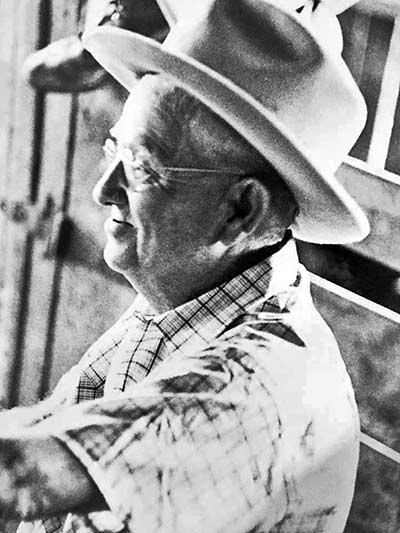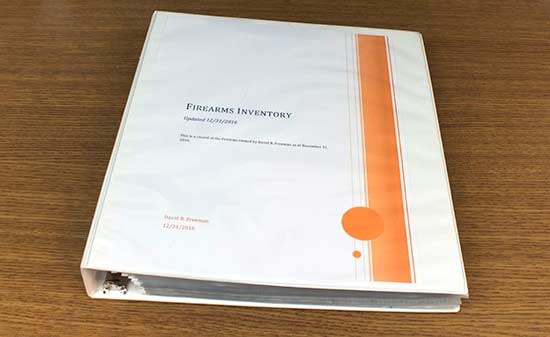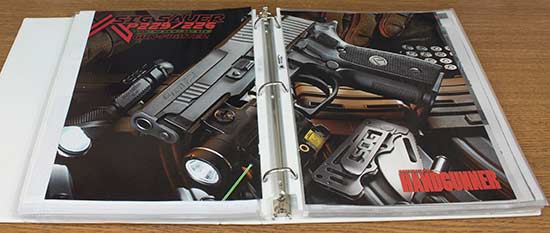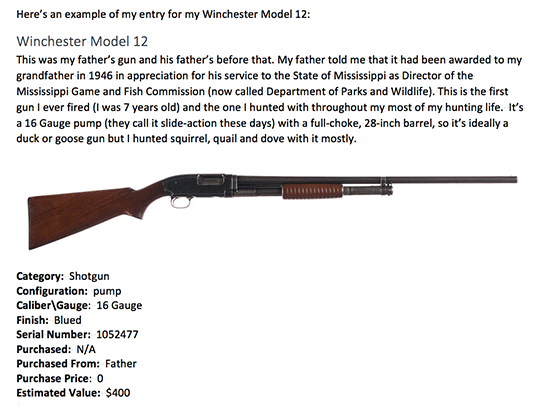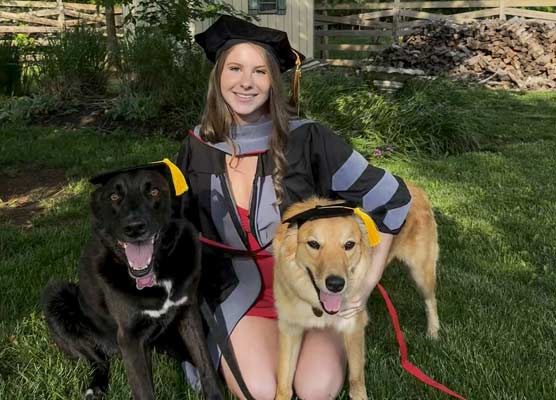Exclusive: Documenting Your Gun Collection
It’s More Than Just Keeping Track — It’s Family History

This is my grandson Josh holding shotguns owned my grandfathers. In his right hand is the LeFever 12
gauge belonging to my maternal grandfather, E.H. Shaw. I got this shotgun as a senior in high school, the year
“Pop” died. In Josh’s left hand is the 16 gauge Winchester Model 12 belonging to my paternal grandfather,
R.M. Freeman. I was given this shotgun by my father when in the 5th grade.
I began documenting my firearms collection for insurance reasons, but quickly realized it was not only important to document the monetary value of the guns as best I could, but also the history behind the special guns in my collection. Some guns should stay in your family simply because they would never have the same value to someone who doesn’t know their history.
In the back of my safe are two shotguns — one originally belonged to my paternal grandfather and the other originally belonged to my maternal grandfather. The first is a Winchester Model 12, 16 gauge built in 1946. The Blue Book of Gun Values lists it as a $400 gun. To me, however, it’s priceless. Not just because it was my grandfather’s gun, but it was also the first gun I ever shot and the one I hunted with throughout my teenage years.
The other is a Lefever 12 gauge, side by side. Lefever is the company that first made a hammerless breakopen double-barrel shotgun. I have no idea what this one is worth because I can’t match it up with the Blue Book descriptions for various models. Values run from $600 to $16,000 or more. No one in my family has ever owned anything at the top end, so I’m fairly certain this one is not up there with the $16,000 guns and is probably one of the $600–$1,000 guns. Either way, it needs to stay in my family. However, it’s not staying as my wife’s home protection shotgun. When I let her shoot it as a newlywed many years ago, that city girl accidentally pulled both triggers at the same time, and it flew out of her hands into the dirt! It is not her favorite gun!
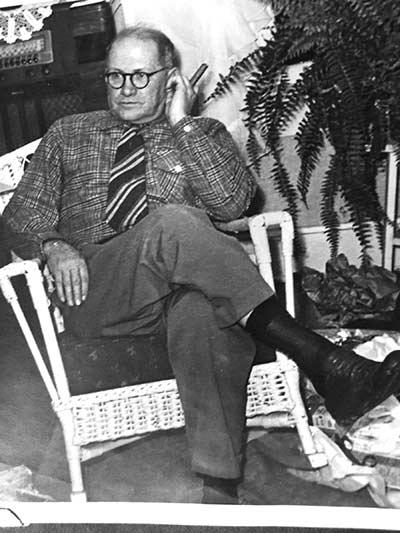
R.M. Freeman was a Pharmacists Mate in the Navy during WWI. He was a conservationist for most
of his life, serving as the Director of the Mississippi Game & Fish Commission (now called the Department
of Parks and Wildlife). He was presented with this Model 12 by the men who worked with him upon his
retirement in 1946. His hunting days over, he gave it to my dad, who gave it to me.
A Gun Story
In the early 1980s, Ruger built a New Model Blackhawk revolver in .357 Maximum, a new caliber designed primarily for hunters and long-range steel plate competition. I was working in the IT department of an online sporting goods distributor with a local gun store. Walking through the store one day I noticed a beautiful revolver in the used gun cabinet. It had a 10.5″ barrel making it look like a Buntline Special. The price was $300. Pretty gun, great price — I bought it.
The salesman wanted to make sure I knew it was a .357 Maximum. I didn’t care as long as I could shoot it. With a little checking I located some .357 Maximum ammo at Old Western Scrounger. I loved the gun but after shooting it and carrying it around I wanted it to have a shorter barrel. It was just too nose-heavy. I checked into ordering a barrel from Ruger and learned they had issued a recall on the .357 Maximums because of a problem with top strap erosion. All the pundits said if there was erosion, or burning, it was caused by handloaders exceeding SAMMI specs in their desire to outdo one another pinging steel plates at long range.
My gun had no erosion. In fact, it looked brand new. But you know Ruger. They’re super careful about the reputation of their firearms, so they wanted all of those Maximums back. They wouldn’t send me a barrel for it, and if I sent it back to them for barrel replacement, they wouldn’t return it. Instead, they would offer me credit toward some other gun in their lineup.
A few years passed and a friend helped me with the barrel length problem. Using his Diamond Saw, we cut the barrel back to just a little over 6″. We coned and rounded the end of the barrel using a Dremel tool and JB-Welded a new sight on it. Using a Birchwood Casey Perma Blue kit I did a fairly decent job of rebluing the new sight and end of the barrel.
Just recently I re-blued the entire gun with a can of DuraBlue from Houts Enterprises LLC. Now who could appreciate a gun like that outside of the family? And where else could you get a gun to teach the effects of ammunition on recoil like this one does when you load it up with two rounds of .38 special, two rounds of .357 Magnum and two rounds of .357 Maximum and have someone shoot all six rounds — bang, bang, bang, bang, bang, bang. They get it. I’ve invested a lot more of me in this gun than it’s actually worth. It should stay in the family.

Though my father was a Fisheries Biologist and spent his 30-year career with the State of Mississippi
as Director of the Fisheries Division, he had Game Warden authority to enforce the laws. He obtained this
Model 10 through a state contract, but never carried it. He thought it was in his sock drawer, but very often
it was with me on camping or fishing trips, horseback riding or just wandering in the woods.
The Mechanics Of Documenting
I know many collectors keep a spreadsheet or a record of receipts for their gun collection, but I wanted to do something that would make it easy for my wife and family to understand what we have when the time comes that I’m out of the picture. I bought a 3-ring binder and a box of sheet protectors at my local office supply store and a low-cost color printer for $69 to begin the task. Using Microsoft Word, I chose a built-in style sheet that has several levels of headers (H1, H2, etc.) and created my own record of my gun collection.
The main headings I selected are: Shotguns, Rimfire Rifles, Centerfire Rifles, Combo Guns, Rimfire Revolvers, Centerfire Revolvers, Rimfire Semi-Autos and Centerfire Semi-Autos. If you decide to do something like this, choose categories that make sense to you (or just list your guns alphabetically or by date acquired).
One thing I did, since I’m using categories, is to start each category on a new page. That makes it easier to add new acquisitions at the end of any of the categories simply by inserting pages as needed. I do periodically reshuffle and reprint the entire document to get rid of guns no longer around and to provide room for new acquisitions in a logical order. Using sheet protectors to hold the pages makes that a fairly simple process.
If you want to add pictures, that is actually a lot easier to do than you might think. While editing your file, open a browser and for each gun, do a Google search for the make and model, displaying the results in the Image tab. Chances are one of the first images that shows up will be a manufacturer’s image, or an image prepared for an online auction. Right click on the image, copy it, then paste it in your inventory document at the correct location.
I list the make and model as the title of each entry, followed by a paragraph of information about the gun. Usually this starts with the Blue Book of Gun Values description, edited as applicable to my particular gun and with any personal comments I want to add. Below that I paste in the photo I found using Google. Or you can take your own photos if you enjoy photography or if some of your guns are so unique there are no photos of them online. If you take photos with a smartphone or digital camera, they are relatively easy to import.
Below the picture, I place a table that includes: Action type, Caliber/Gauge, Finish, Serial Number, Date Purchased, Purchased From, Purchase Price, Estimated Value. For the estimated value, I use the Blue Book information, which is why even if you don’t keep your inventory online with Blue Book, an annual subscription to them is valuable.
More Details
In the back of the book, I post articles about my guns when I find them. I simply tear the article from the magazine and insert it into the page protectors. If I find a better article, I may replace what I previously posted. That’s another reason using sheet protectors is handy.
I keep the book in my safe, which should afford it the same protection from fire as the guns, and makes it easy to find when needed.
For me, this has become something more than just documenting my collection for insurance purposes or to make sure my heirs know what they’ve inherited. Pouring over the book on a cold, rainy evening is almost as much fun as pulling out the guns to look at them. It’s easier on me and the guns because I can’t seem to pull one out and put it back without bumping it on something. I actually enjoy re-reading the descriptions and articles and mulling over the history behind the guns.
Call it a labor of love. If you have a modest collection this should take long at all and is easy to maintain. If you have a big collection, just break it down into the categories and don’t try to do it all at once!

